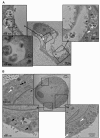Autophagy and lysosomal dysfunction as emerging mechanisms of nanomaterial toxicity
- PMID: 22697169
- PMCID: PMC3441384
- DOI: 10.1186/1743-8977-9-20
Autophagy and lysosomal dysfunction as emerging mechanisms of nanomaterial toxicity
Abstract
The study of the potential risks associated with the manufacture, use, and disposal of nanoscale materials, and their mechanisms of toxicity, is important for the continued advancement of nanotechnology. Currently, the most widely accepted paradigms of nanomaterial toxicity are oxidative stress and inflammation, but the underlying mechanisms are poorly defined. This review will highlight the significance of autophagy and lysosomal dysfunction as emerging mechanisms of nanomaterial toxicity. Most endocytic routes of nanomaterial cell uptake converge upon the lysosome, making the lysosomal compartment the most common intracellular site of nanoparticle sequestration and degradation. In addition to the endo-lysosomal pathway, recent evidence suggests that some nanomaterials can also induce autophagy. Among the many physiological functions, the lysosome, by way of the autophagy (macroautophagy) pathway, degrades intracellular pathogens, and damaged organelles and proteins. Thus, autophagy induction by nanoparticles may be an attempt to degrade what is perceived by the cell as foreign or aberrant. While the autophagy and endo-lysosomal pathways have the potential to influence the disposition of nanomaterials, there is also a growing body of literature suggesting that biopersistent nanomaterials can, in turn, negatively impact these pathways. Indeed, there is ample evidence that biopersistent nanomaterials can cause autophagy and lysosomal dysfunctions resulting in toxicological consequences.
Figures





Similar articles
-
Nanomaterial designing strategies related to cell lysosome and their biomedical applications: A review.Biomaterials. 2019 Aug;211:25-47. doi: 10.1016/j.biomaterials.2019.05.002. Epub 2019 May 3. Biomaterials. 2019. PMID: 31078050 Review.
-
Enhanced translation expands the endo-lysosome size and promotes antigen presentation during phagocyte activation.PLoS Biol. 2019 Dec 4;17(12):e3000535. doi: 10.1371/journal.pbio.3000535. eCollection 2019 Dec. PLoS Biol. 2019. PMID: 31800587 Free PMC article.
-
Coating of Quantum Dots strongly defines their effect on lysosomal health and autophagy.Acta Biomater. 2017 Jan 15;48:195-205. doi: 10.1016/j.actbio.2016.10.022. Epub 2016 Oct 17. Acta Biomater. 2017. PMID: 27765679
-
Pro-Death or Pro-Survival: Contrasting Paradigms on Nanomaterial-Induced Autophagy and Exploitations for Cancer Therapy.Acc Chem Res. 2019 Nov 19;52(11):3164-3176. doi: 10.1021/acs.accounts.9b00397. Epub 2019 Oct 17. Acc Chem Res. 2019. PMID: 31621285 Review.
-
Nanomaterial-induced cell death in pulmonary and hepatic cells following exposure to three different metallic materials: The role of autophagy and apoptosis.Nanotoxicology. 2017 Mar;11(2):184-200. doi: 10.1080/17435390.2017.1279359. Epub 2017 Jan 24. Nanotoxicology. 2017. PMID: 28055265
Cited by
-
An insight into impact of nanomaterials toxicity on human health.PeerJ. 2024 Sep 30;12:e17807. doi: 10.7717/peerj.17807. eCollection 2024. PeerJ. 2024. PMID: 39364370 Free PMC article. Review.
-
Toxicity of graphene-family nanoparticles: a general review of the origins and mechanisms.Part Fibre Toxicol. 2016 Oct 31;13(1):57. doi: 10.1186/s12989-016-0168-y. Part Fibre Toxicol. 2016. PMID: 27799056 Free PMC article. Review.
-
Fluorescent nanodiamonds as a relevant tag for the assessment of alum adjuvant particle biodisposition.BMC Med. 2015 Jun 17;13:144. doi: 10.1186/s12916-015-0388-2. BMC Med. 2015. PMID: 26082187 Free PMC article.
-
Ambient atmospheric PM worsens mouse lung injury induced by influenza A virus through lysosomal dysfunction.Respir Res. 2023 Dec 6;24(1):306. doi: 10.1186/s12931-023-02618-9. Respir Res. 2023. PMID: 38057804 Free PMC article.
-
Maternal exposure to CeO2NPs derails placental development through trophoblast dysfunction mediated by excessive autophagy activation.J Nanobiotechnology. 2022 Mar 15;20(1):131. doi: 10.1186/s12951-022-01334-8. J Nanobiotechnology. 2022. PMID: 35292031 Free PMC article.
References
-
- Stern ST, Johnson DN. Role for nanomaterial-autophagy interaction in neurodegenerative disease. Autophagy. 2008;4:1097–1100. - PubMed
Publication types
MeSH terms
Grants and funding
LinkOut - more resources
Full Text Sources
Other Literature Sources

